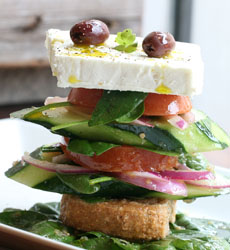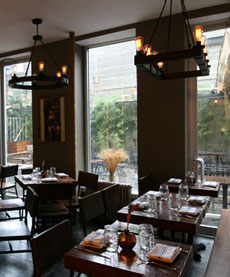RESTAURANT: Death Ave
|
Now that spring is really here, New Yorkers and visitors to the city are heading to the High Line, the elevated train tracks that have been turned into a unique urban park.
Built in 1934 to transport goods through Manhattan, the High Line ran from 34th Street to Spring Street in SoHo. The elevated tracks were built through the center of blocks, rather than over the avenue. By 1980, interstate trucking was the preferred mode of commercial transportation, and the trains ceased to run. Over time, the tracks covered with wild vegetation. Property owners wanted the tracks torn down. In 1999, two neighborhood residents began to advocate for the High Line’s preservation and reuse as public open space. The first part of the renovation opened to the public in 2009 and it is now complete—and magnificent. The High Line is part of the renaissance of the far west side of Chelsea, long a bleak industrial area. A decade ago, art galleries priced out of other neighborhoods led the gentrification, followed by boutique hotels. |

One of Death Ave’s deconstructed dishes, a stacked Greek salad. Photo courtesy Death Ave | NYC. |
|
|
Then the high rise residential buildings began to pop up, many along the High Line. If you’re going to live far west in Chelsea, having a neighborhood park—especially such a hip, trendy one—is an amenity unmatched by other ‘hoods. Along with the burgeoning numbers of visitors and residents came the restaurants. We recently visited a particularly charming one, Death Ave. A RESTAURANT NAMED “DEATH?” First, you’ll say: What kind of name is Death Ave for a restaurant, much less a modern Greek one? Its location, Eleventh Avenue, was nicknamed “Death Avenue” in the late 19th century. In the mid-1800s, the Hudson River Railroad built freight train tracks, to transport meat and other goods to the city’s bustling Meat Packing District (today, there’s no more meat packing but a loft and condo neighborhood). Although inconceivable today, the train tracks ran at street level, right through the same avenue that was used by pedestrians and carriage traffic. Inevitably, hundreds of people were hit and killed by the trains. By the 1890s, the street was nicknamed “Death Avenue.” The stretch of avenue where the restaurant is located is drab, but gentrification will come. And until then, restaurateur Michael Tzezailidis has built a beautiful new restaurant. A 120-year-old tenement building has been transformed into an urban oasis. |
||
 The dining room at Death Ave, looking out onto the patio. Photo courtesy Death Ave | NYC. |
The restaurant has been built with old world craftsmanship. We envied the bronze floor tiles and the handsome stone walls. The room tables are reclaimed wood.
There’s a bar for drinking and nibbling; private, curtain-enclosed booths; a main dining room with and a splendid patio with a retractable roof for rainy days. It has a large bar and lounge area along with table seating. The menu is a creative modernization of Greek fare: a deconstructed Greek salad and souvlaki “tacos” for dinner and deconstructed ham and eggs for breakfast and brunch. There is also more conventional fare, from a mezze plate to braised octopus and lamb shank, all stylishly served. The cocktails are impressive (be sure to have the current specialties); and although we have to return to try the beer, there’s an in-house brewery. Death Ave is an “estiatorio and zythopoiia”; in Greek, estiatorio is a restaurant, zythopoiia is a brewery. It’s a lovely place to relax after your stroll on the High Line. |
|
|
Death Ave is located at 315 10th Avenue between 28th and 29th Streets (not on 11th Avenue, “Death Avenue”); 212.695.8080. You can also reserve via Open Table on the Death Ave website.
|
||


